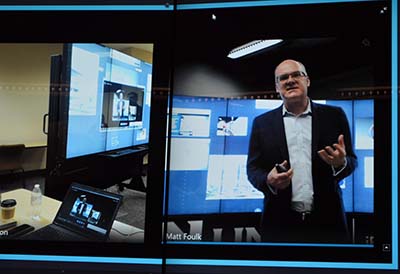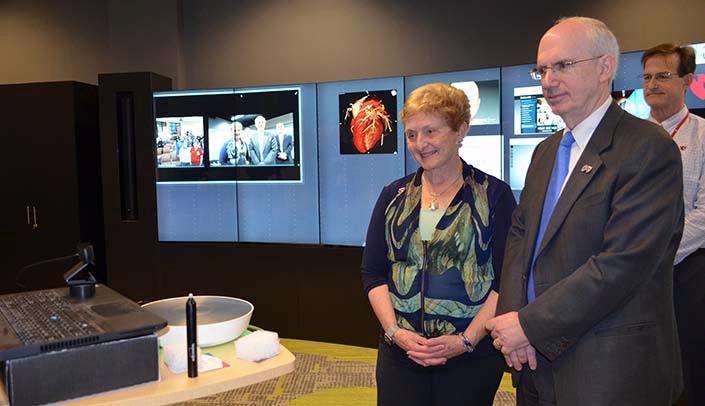First there were chalkboards, then overhead projectors, 35mm slides, Powerpoints and SMART Boards. Now the University of Nebraska Medical Center is moving into much more sophisticated technology for education and research, including the Interactive Digital iWall, 3D technology and augmented and virtual reality.
When the Davis Global Center opens next year, the latest technology will engage learners with hands-on simulated experiences designed to make learning highly realistic.
 |
At the UNMC Sorrell Center in Omaha, Pete Malcolm, CEO of MultiTaction, gives a demonstration of the iWall’s capabilities. On the left side is the connection to Scottsbluff. |
Participating were the iEXCEL team, UNMC and Nebraska Medicine faculty, staff, and students in Omaha and at the UNMC College of Nursing West Nebraska Division and Western Nebraska Community College in Scottsbluff.
Representatives from MultiTaction and AVI-SPL stationed representatives in the Sorrell Center Visualization Hub in Omaha and in Scottsbluff at the college for a first-of-its-kind demo. Pete Malcolm, CEO of MultiTaction, demonstrated what’s possible using the wall, including sharing graphics, photos, video and other resources like websites.
Participants at each location viewed, manipulated and shared information live and could see and hear everything in both locations. Students contributed information and manipulated images on the iWall through personal computers.
The number of participants is only limited by the size of a network and literally hundreds of participants can interact with the walls at the same time, said Malcolm.
The UNMC colleges of nursing, dentistry and allied health professions are considering investing in the interactive walls that show much promise of developing new ways of teaching and learning.
“We’re grateful for the opportunity to see how this works and are excited about it,” said Sue Wilhelm, Ph.D., assistant dean of the UNMC College of Nursing West Nebraska Division. “It worked perfectly. I’m so impressed. I will be interested to see how it’s integrated into curriculum.”
Pamela Boyers, Ph.D., associate vice chancellor for Interprofessional Experiential Center for Enduring Learning (iEXCEL), said a lot of faculty ask about the challenges of learning to use this new technology.
“We’ve thought a lot about that,” Dr. Boyers said. “And to support faculty in working with this technology, we’ll make sure there is sufficient technical support as we continue to adopt these advanced technologies with the goal of improving the learning experience for our students.”
“It was a spectacular demo,” said UNMC Chancellor Jeffrey P. Gold, M.D. “It will help us build the iEXCEL model as we begin our journey into visualization and virtual reality. To me, it’s simply a tool driven by what students need. Our faculty and students should all be able to find the niche that makes magic for them and find the best ways to use it.”
“The demo of the MultiTaction wall in Scottsbluff is a significant step forward in enabling multisite interactive learning for our learners, no matter where they are located,” said Dele Davies, M.D., vice chancellor for academic affairs and dean of graduate studies. “Multiple participants — from sites no matter how remote — can view, annotate and make changes to the same presentation while learning from one another instantaneously. This degree of engagement will significantly increase cross campus collaborative learning and is a critical step toward our goal of linking our learners everywhere via the hub-and-spoke connectedness of iEXCEL.”
